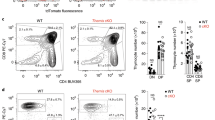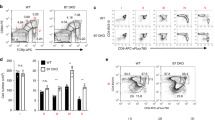Abstract
The inducible co-stimulatory molecule (ICOS) is a CD28 homologue implicated in regulating T-cell differentiation1,2,3,4,5. Because co-stimulatory signals are critical for regulating T-cell activation, an understanding of co-stimulatory signals may enable the design of rational therapies for immune-mediated diseases6. According to the two-signal model for T-cell activation, T cells require an antigen-specific signal and a second, co-stimulatory, signal for optimal T-cell activation6. The co-stimulatory signal promotes T-cell proliferation, lymphokine secretion and effector function. The B7–CD28 pathway provides essential signals for T-cell activation, but does not account for all co-stimulation. We have generated mice lacking ICOS (ICOS-/-) to determine the essential functions of ICOS. Here we report that ICOS-/- mice exhibit profound deficits in immunoglobulin isotype class switching, accompanied by impaired germinal centre formation. Class switching was restored in ICOS-/- mice by CD40 stimulation, showing that ICOS promotes T-cell/B-cell collaboration through the CD40/CD40L pathway.
This is a preview of subscription content, access via your institution
Access options
Subscribe to this journal
Receive 51 print issues and online access
$199.00 per year
only $3.90 per issue
Buy this article
- Purchase on Springer Link
- Instant access to full article PDF
Prices may be subject to local taxes which are calculated during checkout




Similar content being viewed by others

References
McAdam, A. J., Schweitzer, A. N. & Sharpe, A. H. The role of B7 co-stimulation in activation and differentiation of CD4+ and CD8+ T cells. Immunol. Rev. 165, 231–247 ( 1998).
Hutloff, A. et al. ICOS is an inducible T-cell co-stimulator structurally and functionally related to CD28. Nature 397, 263–266 (1999).
Coyle, A. J. et al. The CD28-related molecule ICOS is required for effective T cell-dependent immune responses. Immunity 13, 95–105 (2000).
McAdam, A. J. et al. Mouse inducible costimulatory molecule (ICOS) expression is enhanced by CD28 costimulation and regulates differentiation of CD4+ T cells. J. Immunol. 165, 5035 –5040 (2000).
Yoshinaga, S. K. et al. T-cell co-stimulation through B7RP-1 and ICOS. Nature 402, 827–832 ( 1999).
Mages, H. W. et al. Molecular cloning and characterization of murine ICOS and identification of B7h as ICOS ligand. Eur. J. Immunol. 30, 1040–1047 (2000).
Swallow, M. M., Wallin, J. J. & Sha, W. C. B7h, a novel costimulatory homolog of B7.1 and B7.2, is induced by TNFα. Immunity 11, 423 –432 (1999).
Ling, V. et al. Cutting edge: identification of GL50, a novel B7-like protein that functionally binds to ICOS receptor. J. Immunol. 164 , 1653–1657 (2000).
Brodie, D. et al.LICOS, a primordial costimulatory ligand? Curr. Biol. 10, 333–336 ( 2000).
Wang, S. et al. Costimulation of T cells by B7-H2, a B7-like molecule that binds ICOS. Blood 96, 2808–2813 (2000).
Kopf, M. et al. Inducible costimulator protein (ICOS) controls T helper cell subset polarization after virus and parasite infection. J. Exp. Med. 192, 53–61 ( 2000).
Borriello, F. et al. B7-1 and B7-2 have overlapping, critical roles in immunoglobulin class switching and germinal center formation. Immunity 6, 303–313 (1997).
Tarlinton, D. Germinal centers: form and function. Curr. Opin. Immunol. 10, 245–251 (1998).
Kawabe, T. et al. The immune responses in CD40-deficient mice: impaired immunoglobulin class switching and germinal center formation. Immunity 1, 167–178 (1994).
Borrow, P. et al. CD40L-deficient mice show deficits in antiviral immunity and have an impaired memory CD8+ CTL response. J. Exp. Med. 183, 2129–2142 ( 1996).
Hasbold, J., Johnson-Leger, C., Atkins, C. J., Clark, E. A. & Klaus, G. G. Properties of mouse CD40: cellular distribution of CD40 and B cell activation by monoclonal anti-mouse CD40 antibodies. Eur. J. Immunol. 24, 1835– 1842 (1994).
Roy, M. et al. Studies on the interdependence of gp39 and B7 expression and function during antigen-specific immune responses. Eur. J. Immunol. 25, 596–603 (1995).
Mosmann, T. R. & Sad, S. The expanding universe of T-cell subsets: Th1, Th2 and more. Immunol. Today 17, 138–146 (1996).
Yip, H. C. et al. Adjuvant-guided type-1 and type-2 immunity: infectious/noninfectious dichotomy defines the class of response. J. Immunol. 162, 3942–3949 (1999).
McAdam, A. J., Farkash, E. A., Gewurz, B. E. & Sharpe, A. H. B7 costimulation is critical for antibody class switching and CD8+ cytotoxic T-lymphocyte generation in the host response to vesicular stomatitis virus. J. Virol. 74, 203– 208 (2000).
Greenwald, R. J. et al. Effects of blocking B7-1 and B7-2 interactions during a type 2 in vivo immune response. J. Immunol. 158, 4088–4096 (1997).
Schweitzer, A. N., Borriello, F., Wong, R. C., Abbas, A. K. & Sharpe, A. H. Role of costimulators in T cell differentiation: studies using antigen-presenting cells lacking expression of CD80 or CD86. J. Immunol. 158, 2713-2722 (1997).
Acknowledgements
This work was supported by grants from Genetics Institute (to A.H.S.) and the NIH (to A.J.M., R.J.G., G.J.F. and A.H.S.). We thank M. Collins for thoughtful discussions, and L. Du, J. Burgess and B. Chang for technical support.
Author information
Authors and Affiliations
Corresponding author
Rights and permissions
About this article
Cite this article
McAdam, A., Greenwald, R., Levin, M. et al. ICOS is critical for CD40-mediated antibody class switching. Nature 409, 102–105 (2001). https://doi.org/10.1038/35051107
Received:
Accepted:
Issue Date:
DOI: https://doi.org/10.1038/35051107
This article is cited by
-
Reciprocal costimulatory molecules control the activation of mucosal type 3 innate lymphoid cells during engagement with B cells
Cellular & Molecular Immunology (2023)
-
Structural characterization of the ICOS/ICOS-L immune complex reveals high molecular mimicry by therapeutic antibodies
Nature Communications (2020)
-
Transmembrane domain-mediated Lck association underlies bystander and costimulatory ICOS signaling
Cellular & Molecular Immunology (2020)
-
CXCR5-negative natural killer cells ameliorate experimental autoimmune myasthenia gravis by suppressing follicular helper T cells
Journal of Neuroinflammation (2019)
-
Binding of NUFIP2 to Roquin promotes recognition and regulation of ICOS mRNA
Nature Communications (2018)
Comments
By submitting a comment you agree to abide by our Terms and Community Guidelines. If you find something abusive or that does not comply with our terms or guidelines please flag it as inappropriate.


